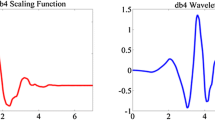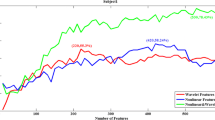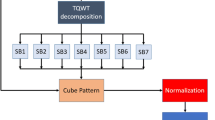Abstract
This paper introduces a method to classify EEG signals using features extracted by an integration of wavelet transform and the nonparametric Wilcoxon test. Orthogonal Haar wavelet coefficients are ranked based on the Wilcoxon test’s statistics. The most prominent discriminant wavelets are assembled to form a feature set that serves as inputs to the naïve Bayes classifier. Two benchmark datasets, named Ia and Ib, downloaded from the brain–computer interface (BCI) competition II are employed for the experiments. Classification performance is evaluated using accuracy, mutual information, Gini coefficient and F-measure. Widely used classifiers, including feedforward neural network, support vector machine, k-nearest neighbours, ensemble learning Adaboost and adaptive neuro-fuzzy inference system, are also implemented for comparisons. The proposed combination of Haar wavelet features and naïve Bayes classifier considerably dominates the competitive classification approaches and outperforms the best performance on the Ia and Ib datasets reported in the BCI competition II. Application of naïve Bayes also provides a low computational cost approach that promotes the implementation of a potential real-time BCI system.








Similar content being viewed by others
References
Sabeti M, Katebi SD, Boostani R, Price GW (2011) A new approach for EEG signal classification of schizophrenic and control participants. Expert Syst Appl 38(3):2063–2071
Vidaurre C, Kawanabe M, von Bunau P, Blankertz B, Muller KR (2011) Toward unsupervised adaptation of LDA for brain–computer interfaces. IEEE Trans Biomed Eng 58(3):587–597
Li Y, Koike Y (2011) A real-time BCI with a small number of channels based on CSP. Neural Comput Appl 20(8):1187–1192
Zhang R, Xu P, Guo L, Zhang Y, Li P, Yao D (2013) Z-score linear discriminant analysis for EEG based brain–computer interfaces. PLoS ONE 8(9):e74433
Hosseinifard B, Moradi MH, Rostami R (2013) Classifying depression patients and normal subjects using machine learning techniques and nonlinear features from EEG signal. Comput Methods Programs Biomed 109(3):339–345
Prasad P, Halahalli H, John J, Majumdar K (2014) Single-trial EEG classification using logistic regression based on ensemble synchronization. IEEE J Biomed Health Inform 18(3):2014
Li Y, Wen PP (2014) Modified CC-LR algorithm with three diverse feature sets for motor imagery tasks classification in EEG based brain computer interface. Comput Methods Programs Biomed 113(3):767–780
Wang D, Miao D, Xie C (2011) Best basis-based wavelet packet entropy feature extraction and hierarchical EEG classification for epileptic detection. Expert Syst Appl 38(11):14314–14320
Guo L, Rivero D, Dorado J, Munteanu CR, Pazos A (2011) Automatic feature extraction using genetic programming: an application to epileptic EEG classification. Expert Syst Appl 38(8):10425–10436
Acharya UR, Molinari F, Sree SV, Chattopadhyay S, Ng KH, Suri JS (2012) Automated diagnosis of epileptic EEG using entropies. Biomed Signal Process Control 7(4):401–408
Garrett D, Peterson DA, Anderson CW, Thaut MH (2003) Comparison of linear, nonlinear, and feature selection methods for EEG signal classification. IEEE Trans Neural Syst Rehabil Eng 11(2):141–144
Vatankhah M, Asadpour V, Fazel-Rezai R (2013) Perceptual pain classification using ANFIS adapted RBF kernel support vector machine for therapeutic usage. Appl Soft Comput 13(5):2537–2546
Joshi V, Pachori RB, Vijesh A (2014) Classification of ictal and seizure-free EEG signals using fractional linear prediction. Biomed Signal Process Control 9:1–5
Subasi A, Erçelebi E (2005) Classification of EEG signals using neural network and logistic regression. Comput Methods Programs Biomed 78(2):87–99
Ting W, Guo-zheng Y, Bang-hua Y, Hong S (2008) EEG feature extraction based on wavelet packet decomposition for brain computer interface. Measurement 41(6):618–625
Guo L, Rivero D, Dorado J, Rabunal JR, Pazos A (2010) Automatic epileptic seizure detection in EEGs based on line length feature and artificial neural networks. J Neurosci Methods 191(1):101–109
Özbay Y, Ceylan R, Karlik B (2011) Integration of type-2 fuzzy clustering and wavelet transform in a neural network based ECG classifier. Expert Syst Appl 38(1):1004–1010
Ahangi A, Karamnejad M, Mohammadi N, Ebrahimpour R, Bagheri N (2013) Multiple classifier system for EEG signal classification with application to brain–computer interfaces. Neural Comput Appl 23(5):1319–1327
Subasi A, Gursoy MI (2010) EEG signal classification using PCA, ICA, LDA and support vector machines. Expert Syst Appl 37(12):8659–8666
Gandhi T, Panigrahi BK, Anand S (2011) A comparative study of wavelet families for EEG signal classification. Neurocomputing 74(17):3051–3057
Siuly, Li Y, Wen PP (2011) Clustering technique-based least square support vector machine for EEG signal classification. Comput Methods Programs Biomed 104(3):358–372
Sun S, Lu Y, Chen Y (2011) The stochastic approximation method for adaptive Bayesian classifiers: towards online brain–computer interfaces. Neural Comput Appl 20(1):31–40
Hsu WY (2011) EEG-based motor imagery classification using enhanced active segment selection and adaptive classifier. Comput Biol Med 41(8):633–639
Hu S, Tian Q, Cao Y, Zhang J, Kong W (2013) Motor imagery classification based on joint regression model and spectral power. Neural Comput Appl 23(7–8):1931–1936
Cinar E, Sahin F (2013) New classification techniques for electroencephalogram (EEG) signals and a real-time EEG control of a robot. Neural Comput Appl 22(1):29–39
Subha DP, Joseph PK, Acharya R, Lim CM (2010) EEG signal analysis: a survey. J Med Syst 34(2):195–212
McFarland DJ, Anderson CW, Muller K, Schlogl A, Krusienski DJ (2006) BCI meeting 2005-workshop on BCI signal processing: feature extraction and translation. IEEE Trans Neural Syst Rehabil Eng 14(2):135
Li D, Pedrycz W, Pizzi NJ (2005) Fuzzy wavelet packet based feature extraction method and its application to biomedical signal classification. IEEE Trans Biomed Eng 52(6):1132–1139
Tan Y, Li G, Duan H, Li C (2014) Enhancement of medical image details via wavelet homomorphic filtering transform. J Intell Syst 23(1):83–94
Torbati N, Ayatollahi A, Kermani A (2014) An efficient neural network based method for medical image segmentation. Comput Biol Med 44:76–87
Nguyen T, Khosravi A, Creighton D, Nahavandi S (2014) Classification of healthcare data using genetic fuzzy logic system and wavelets. Expert Syst Appl. doi:10.1016/j.eswa.2014.10.027
Mensh BD, Werfel J, Seung HS (2004) BCI competition 2003-data set Ia: combining gamma-band power with slow cortical potentials to improve single-trial classification of electroencephalographic signals. IEEE Trans Biomed Eng 51(6):1052–1056
Bostanov V (2004) BCI competition 2003-data sets Ib and IIb: feature extraction from event-related brain potentials with the continuous wavelet transform and the t-value scalogram. IEEE Trans Biomed Eng 51(6):1057–1061
Bishop CM (2006) Pattern recognition and machine learning. Springer, New York
DeVore RA, Lucier BJ (1992) Wavelets. Acta Numer 1(1):1–56
Quiroga RQ, Nadasdy Z, Ben-Shaul Y (2004) Unsupervised spike detection and sorting with wavelets and superparamagnetic clustering. Neural Comput 16(8):1661–1687
Deng L, Pei J, Ma J, Lee DL (2004) A rank sum test method for informative gene discovery. In: Proceedings of the tenth ACM SIGKDD international conference on knowledge discovery and data mining, pp 410–419
Lehmann EL, D’Abrera HJ (2006) Nonparametrics: statistical methods based on ranks. Springer, New York
Birbaumer N, Flor H, Ghanayim N, Hinterberger T, Iverson I, Taub E, Kotchoubey B, Kübler A, Perelmouter J (1999) A brain-controlled spelling device for the completely paralyzed. Nature 398:297–298
Kruskal WH, Wallis WA (1952) Use of ranks in one-criterion variance analysis. J Am Stat Assoc 47(260):583–621
Author information
Authors and Affiliations
Corresponding author
Rights and permissions
About this article
Cite this article
Nguyen, T., Khosravi, A., Creighton, D. et al. EEG data classification using wavelet features selected by Wilcoxon statistics. Neural Comput & Applic 26, 1193–1202 (2015). https://doi.org/10.1007/s00521-014-1802-y
Received:
Accepted:
Published:
Issue Date:
DOI: https://doi.org/10.1007/s00521-014-1802-y




